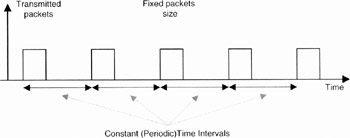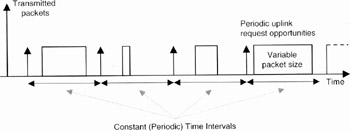11.3 The Five Scheduling Services or QoS Classes
11.3 The Five Scheduling Services or QoS Classes
The IEEE 802.16 standard provides powerful tools in order to achieve different QoS constraints. The 802.16 standard MAC Layer provides QoS differentiation for the different types of applications that might operate over 802.16 networks, through five defined scheduling service types, also called QoS classes.
This classification into these scheduling service classes facilitates bandwidth sharing between different users. Every user has a quality of scheduling service class, also known as QoS class. According to this parameter, the BS scheduler allocates the necessary amount of bandwidth required for each application. This mechanism allows an efficient and adapted distribution of the existing resources. Therefore, a real-time application, such as a video application, will have the priority in bandwidth allocation in comparison with FTP (File Transfer Protocol) or email applications. This is not the case, for example, with the presently used WiFi (WLAN) system where all services have exactly the same level of QoS.
Scheduling services represent the data handling mechanisms supported by the MAC scheduler for data transport on a given connection. Uplink request (grant) scheduling is performed by the BS based on the scheduling service type, with the intent of providing each subordinate SS with a bandwidth for uplink transmissions and opportunities to request this bandwidth, when needed. As already mentioned in this book, each connection is associated with a single data service flow and each service flow is associated with a set of QoS parameters. These parameters are managed using the DSA and DSC MAC management messages dialogues (see Section 11.4). Four scheduling services were defined in 802.16e:
-
Unsolicited Grant Service (UGS);
-
real-time Polling Service (rtPS);
-
non-real-time Polling Service (nrtPS);
-
Best Effort (BE).
A fifth scheduling service type was added in 802.16e:
-
Extended Real-time Polling Service (ertPS);
Each of these scheduling services has a mandatory set of QoS parameters that must be included in the service flow definition when the scheduling service is enabled for a service flow. The QoS parameters defined in the 802.16 standard are described in Section 7.4. Table 11.3 gives the mandatory service flow QoS parameters for each of the four scheduling services defined in 802.16-2004. If present, the minimum reserved traffic rate parameter of UGS must have the same value as the maximum sustained traffic rate parameter. Concerning ertPS, 802.16e indicates that the key service IEs are the maximum sustained traffic rate, the minimum reserved traffic rate, the maximum latency and the request/transmission policy.
| Scheduling service | Maximum sustained traffic rate | Minimum reserved traffic rate | Request/transmission policy | Tolerated jitter | Maximum latency | Traffic priority |
|---|---|---|---|---|---|---|
| UGS | • | (Can be present | • | • | • | |
| rtPS | • | • | • | • | ||
| nrtPS | • | • | • | • | ||
| BE | • | • | • |
Uplink request/grant scheduling is performed by the BS in order to provide each SS with a bandwidth for uplink transmissions and opportunities to request a bandwidth, when needed. By specifying a scheduling service and its associated QoS parameters, the BS scheduler can anticipate the throughput and latency needs of the uplink traffic and provide polls and/or grants at the appropriate times. Table 11.4 summarises the poll/grant options available for each of the scheduling services.
| Scheduling service | Piggyback grant request | Bandwidth stealing | Unicast polling | Contention-based polling |
|---|---|---|---|---|
| UGS | Allowed | Allowed | PM (Poll-Me) bit can be used | Not allowed |
| ertPS | Extended piggyback | Allowed | Allowed | Allowed |
| rtPS | Not allowed | Not allowed | Allowed | Not allowed |
| nrtPS | Not allowed | Not allowed | Allowed | Allowed |
| BE | Not allowed | Not allowed | Allowed | Allowed |
More details for each scheduling service are provided in the following subsections.
11.3.1 Unsolicited Grant Service (UGS)
The UGS scheduling service type is designed to support real-time data streams consisting of fixed-size data packets issued at periodic intervals. This would be the case, for example, for TI/EI classical PCM (Pulse Coded Modulation) phone signal transmission and Voice over IP without silence suppression.
In a UGS service, the BS provides fixed-size data grants at periodic intervals. This eliminates the overhead and latency of SS requests. Figure 11.7 illustrates the UGS mechanism. The BS provides Data Grant Burst IEs (UL-MAP_IEs, see Chapter 10) to the SS at periodic intervals based upon the maximum sustained traffic rate of the service flow. The size of these grants is sufficient to hold the fixed-length data associated with the service flow, taking into account the associated generic MAC header and grant management subheader.

Figure 11.7: UGS scheduling service uplink grants allocation mechanism
The grant management subheader (see Chapter 10) is used to pass status information from the SS to the BS regarding the state of the UGS service flow. If the SI (Slip Indicator) bit of the grant management field is set, the BS may grant up to 1% additional bandwidth for clock rate mismatch compensation. The SSs that have an active UGS connection are not polled individually (by the BS) unless they set the PM bit in the header (precisely, in the grant management subheader) of a packet on the UGS connection.
11.3.2 Extended Real-Time Polling Service (ertPS)
The ertPS (extended real-time Polling Service) class was added by the 802.16e amendment. The standard [2] indicates that ertPS is a scheduling mechanism that builds on the efficiency of both UGS and rtPS. The BS provides unicast grants in an unsolicited manner like in UGS, thus saving the latency of a bandwidth request. However, whereas UGS allocations are fixed in size, ertPS allocations are dynamic. The ertPS is suitable for variable rate real-time applications that have data rate and delay requirements. An example is Voice over IP without silence suppression.
11.3.3 Real-Time Polling Service (rtPS)
The rtPS scheduling service type is designed to support real-time data streams consisting of variable-sized data packets that are issued at periodic intervals. This would be the case, for example, for MPEG (Moving Pictures Experts Group) video transmission.
In this service, the BS provides periodic unicast (uplink) request opportunities, which meet the flow's real-time needs and allow the SS to specify the size of the desired grant. This service requires more request overheads than UGS, but supports variable grant sizes for optimum real-time data transport efficiency. Figure 11.8 shows the rtPS mechanism.

Figure 11.8: rtPS scheduling service uplink grants allocation and request mechanism
11.3.4 Non-Real-Time Polling Service (nrtPS)
The nrtPS is designed to support delay-tolerant data streams consisting of variable-size data packets for which a minimum data rate is required. The standard considers that this would be the case, for example, for an FTP transmission. In the nrtPS scheduling service, the BS provides unicast uplink request polls on a ‘regular’ basis, which guarantees that the service flow receives request opportunities even during network congestion. The standard states that the BS typically polls nrtPS CIDs on an interval on the order of one second or less. In addition, the SS is allowed to use contention request opportunities, i.e. the SS may use contention request opportunities as well as unicast request opportunities. Figure 11.9 shows the nrtPS mechanism.

Figure 11.9: Illustration of the nrtPS scheduling service uplink grants allocation and request mechanism. The SS may use contention request opportunities as well as unicast request opportunities
11.3.5 Best Effort (BE)
The BE service is designed to support data streams for which no minimum service guarantees are required and therefore may be handled on a best available basis. The SS may use contention request opportunities as well as unicast request opportunities when the BS sends any. The BS do not have any unicast uplink request polling obligation for BE SSs. Therefore, a long period can run without transmitting any BE packets, typically when the network is in the congestion state. Figure 11.10 shows the BE mechanism.

Figure 11.10: Illustration of the BE scheduling service uplink grants allocation and request mechanism. The BS does not have any unicast uplink request polling obligation for a BE SS
[2]IEEE 802.16e, IEEE Standard for Local and Metropolitan Area Networks, Air Interface for Fixed Broadband Wireless Access Systems, Amendment 2: Physical and Medium Access Control Layers for Combined Fixed and Mobile Operation in Licensed Bands and Corrigendum 1, February 2006 (Approved: 7 December 2005).
EAN: 2147483647
Pages: 124